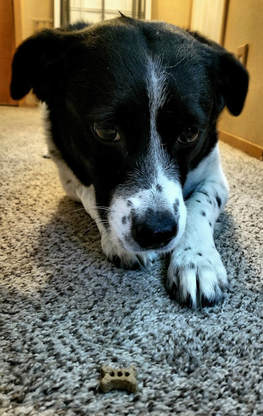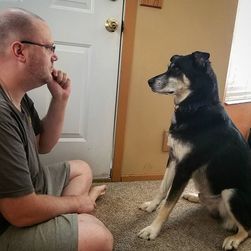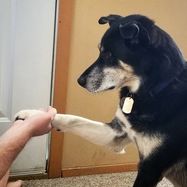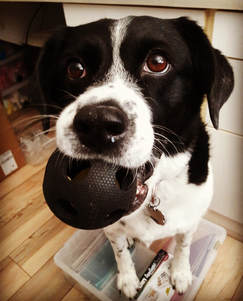 There are three things I have learned since getting Luna that I wish someone would have taught me in our early days. Place, touch, and wait. We've picked up each of them at different times and from several people. Now I consider them essential for a well-trained dog. I introduce them in puppy class and offer them as solutions to friends and coworkers. Because they are a foundation for Trick Dog I have a planned post for each of them, but wanted to start with wait. Wait and stay are similar commands, yet vastly different. With stay you are asking your dog to remain in the exact place and position you have left them. Sit/stay, means to sit where you are until I come back. That doesn't mean down, and it doesn't mean moving forward to see how much ground you can steal before I turn around. This isn't baseball. Stay is serious business because it could save your dog’s life. Stay also doesn't mean I am going to call you to me. If you are an experienced dog owner, you may have just reread that sentence. Maybe you stared at it in disbelief. It comes off a little crazy, right? What do you mean, you can't call your dog to you from a stay? Remember, stay isn't voluntary or conditional. Stay means you remain exactly where you are until I come back. Which means if you are calling your dog to you you are breaking down the strength of the command. Now, hopefully, you've accepted that the idea of not calling your dog from a stay isn’t crazy. Or at least are open minded enough to keep reading. Because this is where wait comes in.
1 Comment
Call it shake, paw, or pick your own command, teaching your dog to lift their paw for you is a trick staple. It's the one that strangers on the street will ask your dog, “Can you shake?” And wait for your dog’s non-verbal answer. Maybe it’s because we associate shaking hands as etiquette. But whatever the reason, shake is a crowd pleaser. It also leads to dozens of other tricks: wave, high five (or ten), to name the easier ones. Ironically, shake is one of the few tricks that Luna didn’t seem to ‘get’ for the longest time. I assumed it would be easiest to pick up her paw for her, ‘shake’ it while repeating the command. I figured she would either recognize the word or the hand signal, but she always just looked at me confused. After a while I gave up and moved on to tricks she was more naturally inclined to do. Turned out I was doing it wrong. Or at least wrong for her. Since then I have found that whenever possible you need to lure your dog into doing whatever it is you are asking of them. While I was attempting to teach her shake I was in fact doing the motion for her. In her mind we were doing the trick as designed, and I guess she’s right. Ready to give it a try? Paw is best taught on the ground with your dog in a sitting position in front of you. Take a tasty treat (the tastier the better) and let them watch you put it in a closed fist. Place your hand on the ground just in front of their paws. Your dog will probably sniff at the treat, they may lie down, or even lick your hand. As soon as their paw leaves the ground mark the behavior (such as using the word ‘yes’!), followed by the command (good paw), and then reward them with the treat. Continue to praise and reward for raising the paw. Transition to holding your hand open, palm up, and shaking before raising your arm to a greater height. Your goal should be chest high for the dog. Every dog learns this trick at a different pace. Once Luna understood I wanted her paw to touch my hand she was shaking after just a few sessions. Ella still paws at me half the time, and for Charlie it’s one of his favorite tricks. Already have it mastered? Try taking shake to a new level. Teach your dog to switch paws. Like humans they have a preference between right and left. Or move your hand away to teach wave, hand forward and towards them for high five. When teaching additional tricks it is often helpful to use both the new and old command at first. For example, with wave I would call it ‘shake wave’ to encourage the paw lift. Now for a real challenge explore your own tricks involving paw. Think buttons and switches - even musical instruments. Have a unique way of using the paw command? Let us know in the comments below.  Luna practicing 'On" and "Hold". Luna practicing 'On" and "Hold". I promised a few posts ago that we would post more on Trick Dog. Last week Luna and I set out to sign off her Novice, Intermediate, and Advanced titles. To some, it may sound like a rush, but I wanted to get hers finished and off the table so I could move onto Ella and Charlie. Not that it means we’re done, because constant training keeps Luna happy and strengthens our bond. She completed 20 tricks last Saturday to obtain all three titles. Her wave was a little sketchy...but she had also only learned it that same week. There is still one more title she can earn, Performer, but we have to do a video for that. If I’m going that far with it I want to put a whole sketch together. I’m thinking something musically inclined, as we are working on ‘keys’ with Dad’s keyboard. As I mentioned before, I want to share the Trick Dog journey with you. But to be honest Luna's is towards the end of that path, so we’ll be focusing more on Charlie and Ella. Not that she won’t still make an appearance now and then, because, well, it’s Luna. So how do you get started in Trick Dog? A good starting place would be to find a local AKC obedience club. If you don’t have one available or you want to go it alone start by picking up Kyra Sundance’s 101 Dog Tricks. I recommend everyone, whether or not you are interested in Trick Dog, to complete a basic training program. This should include getting your Canine Good Citizen (CGC). Depending on the program you choose and how much training you have done on your own this may take more than one complete class. Luna and I have been excited for the new Trick Dog titles ever since the American Kennel Club (AKC) announced the program in May. The AKC partnered with Kyra Sundance’s Do More With Your Dog and is designed for all dogs to participate.
“Tricks” are something Luna has done almost naturally since the day she came into our house. Whether it was something she picked up during a quick training session (balancing a treat) or she just did (perch - front paws on an item like a stool). A natural worker and eager to please, grab a handful of treats and give her some one-on-one time and Luna’s ready to go! There are so many things I love about this program’s design. First, it’s simple to get involved in. You can find a list of all the tricks for each title (Novice, Intermediate, Advanced, and Performer) on the AKC’s website. This makes it easy for you to practice at home at your own pace if you can’t find classes near you. Kyra Sundance even released a book called 101 Dog Tricks that contains many of the tricks with step-by-step instructions. Once you’re ready to title you don’t have to wait for a dog show or compete dozens of times. All Trick Dog titles just have to be passed off by an AKC Canine Good Citizen (CGC) Evaluator. Trick Dog also allows you to dip your toes into the world of several AKC sports. There are obedience tricks involving the basics of sit and down alongside agility equipment like the weave poles and tunnel. And if these are commands your dog is familiar with you can challenge yourself with tricks such as pulling a toy with a rope or balancing on a barrel. Trick Dog is designed to be fun and I think it meets that goal. Over the next few weeks we’ll have more updates on our Trick Dog journey. I hope it will inspire you to do more with your own dog, even if you never decide to title. |
AuthorLisa (and Luna) Archives
November 2017
Categories
All
|
- Home
- Worldly Dogs Blog
-
Breeds Geographically
- Africa >
-
Asia
>
- Australia >
-
Europe
>
- Austria >
- Belgium >
- Bosnia and Herzegovina >
- Croatia >
- Czech Republic >
- Denmark >
-
England
>
- Airedale Terrier
- Basset Hound
- Beagle
- Bedlington Terrier
- Border Collie
- Border Terrier
- Bull Terrier
- Bulldog
- Bullmastiff
- Cavalier King Charles Spaniel
- Clumber Spaniel
- Curly Coated Retriever
- English Cocker Spaniel
- English Foxhound
- English Setter
- English Springer Spaniel
- English Toy Spaniel
- Field Spaniel
- Flat Coated Retriever
- Greyhound
- Harrier
- Jack Russell Terrier
- Lakeland Terrier
- Lancashire Heeler
- Manchester Terrier
- Mastiff
- Miniature Bull Terrier
- Norfolk Terrier
- Norwich Terrier
- Old English Sheepdog
- Otterhound
- Parson Russell Terrier
- Patterdale Terrier
- Pointer
- Smooth Fox Terrier
- Sporting Lucas Terrier
- Staffordshire Bull Terrier
- Sussex Spaniel
- Whippet
- Wire Fox Terrier
- Yorkshire Terrier
- Finland >
-
France
>
- Anglo-Français de Petite Vénerie
- Ariégeois
- Barbet
- Basset Artésien Normand
- Basset Bleu de Gascogne
- Basset Fauve de Bretagne
- Beagle Harrier
- Beauceron
- Berger Picard
- Bichon Frisé
- Billy
- Blue Picardy Spaniel
- Braque d'Auvergne
- Braque de l'Ariége
- Braque Du Bourbonnais
- Braque Français
- Braque Saint-Germain
- Briard
- Briquet Griffon Vendéen
- Brittany
- Chien d'Artois
- Chien Français Blanc et Noir
- Chien Français Blanc et Orange
- Chien Français Tricolore
- Dogue de Bordeaux
- French Bulldog
- French Spaniel
- Grand Anglo-Français Blanc et Noir
- Grand Anglo-Français Blanc et Orange
- Grand Anglo-Français Tricolore
- Grand Basset Griffon Vendéen
- Grand Bleu de Gascogne
- Grand Gascon-Saintongeois
- Grand Griffon Vendéen
- Great Pyrenees
- Griffon Bleu de Gascogne
- Griffon Fauve de Bretagne
- Griffon Nivernais
- Löwchen
- Petit Basset Griffon Vendéen
- Petit Bleu de Gascogne
- Petit Gascon-Saintongeois
- Picardy Spaniel
- Poitevin
- Pont-Audemer Spaniel
- Porcelaine
- Pyrenean Shepherd
- Wirehaired Pointing Griffon
-
Germany
>
- Affenpinscher
- Bavarian Mountain Hound
- Biewer Terrier
- Boxer
- Dachshund
- Deutsche Bracke
- Deutscher Wachtelhund
- Doberman Pinscher
- Eurasier
- German Longhaired Pointer
- German Pinscher
- German Rough Haired Pointer
- German Shepherd Dog
- German Shorthaired Pointer
- German Spitz
- German Wirehaired Pointer
- Giant Schnauzer
- Great Dane
- Hanoverian Hound
- Hovawart
- Jagdterrier
- Kromfohrländer
- Large Münsterländer
- Leonberger
- Miniature Pinscher
- Miniature Schnauzer
- Pomeranian
- Poodle
- Pudelpointer
- Rottweiler
- Schnauzer
- Small Münsterländer
- Weimaraner
- Westphalian Dachsbracke
- White Shepherd Dog
- Greece >
- Hungary >
- Ireland >
- Italy >
- Malta >
- Netherlands >
- Norway >
- Poland >
- Portugal >
- Romania >
- Russia >
- Scotland >
- Serbia >
- Slovakia >
- Spain >
- Sweden >
- Switzerland >
- Turkey >
- Wales >
- Other European Breeds >
-
North America
>
- Canada >
- Mexico >
-
United States
>
- Alaskan Klee Kai
- Alaskan Malamute
- American Bulldog
- American Bully
- American Cocker Spaniel
- American Eskimo Dog
- American Foxhound
- American Hairless Terrier
- American Leopard Hound
- American Pit Bull Terrier
- American Staffordshire Terrier
- American Water Spaniel
- Australian Shepherd
- Black and Tan Coonhound
- Black Mouth Cur
- Bluetick Coonhound
- Boston Terrier
- Boykin Spaniel
- Carolina Dog
- Catahoula Leopard Dog
- Chesapeake Bay Retriever
- Chinook
- English Coonhound
- English Shepherd
- Miniature American Shepherd
- Mountain Cur
- Olde English Bulldogge
- Plott Hound
- Rat Terrier
- Redbone Coonhound
- Silken Windhound
- Stephens' Cur
- Teddy Roosevelt Terrier
- Toy Fox Terrier
- Treeing Cur
- Treeing Feist
- Treeing Tennessee Brindle
- Treeing Walker Coonhound
- Other North American Breeds >
- South America >
- Alphabetical List
- Breeds By Type
-
Extinct
- African Sand Dog
- Bichon Tenerife
- Basset d'Artois
- Basset Normand
- Basset Saintongeois
- Black and Tan Terrier
- Blanquito de la Habana
- Bouvier des Moerman
- Bouvier des Paret
- Bouvier des Roulers
- Bullenbeisser
- Celtic Hound
- Céris
- Chien Blanc du Roi
- Coton de Reunion
- English Red Decoy Dog
- Grand Fauve de Bretagne
- Griffon d’Ecurie
- Hall's Heeler
- Han Dog
- Happa Dog
- Larye
- Leauvenaar
- Molossus
- Montembeouf
- Normand Hound
- Paisley Terrier
- Saint Hubert Hound
- Saintongeois Hound
- Tahltan Bear Dog
- Tesem
- Timmon's Biter
-
Kennel Clubs
- About Worldly Dogs
Worldly Dogs 2017
- Home
- Worldly Dogs Blog
-
Breeds Geographically
- Africa >
-
Asia
>
- Australia >
-
Europe
>
- Austria >
- Belgium >
- Bosnia and Herzegovina >
- Croatia >
- Czech Republic >
- Denmark >
-
England
>
- Airedale Terrier
- Basset Hound
- Beagle
- Bedlington Terrier
- Border Collie
- Border Terrier
- Bull Terrier
- Bulldog
- Bullmastiff
- Cavalier King Charles Spaniel
- Clumber Spaniel
- Curly Coated Retriever
- English Cocker Spaniel
- English Foxhound
- English Setter
- English Springer Spaniel
- English Toy Spaniel
- Field Spaniel
- Flat Coated Retriever
- Greyhound
- Harrier
- Jack Russell Terrier
- Lakeland Terrier
- Lancashire Heeler
- Manchester Terrier
- Mastiff
- Miniature Bull Terrier
- Norfolk Terrier
- Norwich Terrier
- Old English Sheepdog
- Otterhound
- Parson Russell Terrier
- Patterdale Terrier
- Pointer
- Smooth Fox Terrier
- Sporting Lucas Terrier
- Staffordshire Bull Terrier
- Sussex Spaniel
- Whippet
- Wire Fox Terrier
- Yorkshire Terrier
- Finland >
-
France
>
- Anglo-Français de Petite Vénerie
- Ariégeois
- Barbet
- Basset Artésien Normand
- Basset Bleu de Gascogne
- Basset Fauve de Bretagne
- Beagle Harrier
- Beauceron
- Berger Picard
- Bichon Frisé
- Billy
- Blue Picardy Spaniel
- Braque d'Auvergne
- Braque de l'Ariége
- Braque Du Bourbonnais
- Braque Français
- Braque Saint-Germain
- Briard
- Briquet Griffon Vendéen
- Brittany
- Chien d'Artois
- Chien Français Blanc et Noir
- Chien Français Blanc et Orange
- Chien Français Tricolore
- Dogue de Bordeaux
- French Bulldog
- French Spaniel
- Grand Anglo-Français Blanc et Noir
- Grand Anglo-Français Blanc et Orange
- Grand Anglo-Français Tricolore
- Grand Basset Griffon Vendéen
- Grand Bleu de Gascogne
- Grand Gascon-Saintongeois
- Grand Griffon Vendéen
- Great Pyrenees
- Griffon Bleu de Gascogne
- Griffon Fauve de Bretagne
- Griffon Nivernais
- Löwchen
- Petit Basset Griffon Vendéen
- Petit Bleu de Gascogne
- Petit Gascon-Saintongeois
- Picardy Spaniel
- Poitevin
- Pont-Audemer Spaniel
- Porcelaine
- Pyrenean Shepherd
- Wirehaired Pointing Griffon
-
Germany
>
- Affenpinscher
- Bavarian Mountain Hound
- Biewer Terrier
- Boxer
- Dachshund
- Deutsche Bracke
- Deutscher Wachtelhund
- Doberman Pinscher
- Eurasier
- German Longhaired Pointer
- German Pinscher
- German Rough Haired Pointer
- German Shepherd Dog
- German Shorthaired Pointer
- German Spitz
- German Wirehaired Pointer
- Giant Schnauzer
- Great Dane
- Hanoverian Hound
- Hovawart
- Jagdterrier
- Kromfohrländer
- Large Münsterländer
- Leonberger
- Miniature Pinscher
- Miniature Schnauzer
- Pomeranian
- Poodle
- Pudelpointer
- Rottweiler
- Schnauzer
- Small Münsterländer
- Weimaraner
- Westphalian Dachsbracke
- White Shepherd Dog
- Greece >
- Hungary >
- Ireland >
- Italy >
- Malta >
- Netherlands >
- Norway >
- Poland >
- Portugal >
- Romania >
- Russia >
- Scotland >
- Serbia >
- Slovakia >
- Spain >
- Sweden >
- Switzerland >
- Turkey >
- Wales >
- Other European Breeds >
-
North America
>
- Canada >
- Mexico >
-
United States
>
- Alaskan Klee Kai
- Alaskan Malamute
- American Bulldog
- American Bully
- American Cocker Spaniel
- American Eskimo Dog
- American Foxhound
- American Hairless Terrier
- American Leopard Hound
- American Pit Bull Terrier
- American Staffordshire Terrier
- American Water Spaniel
- Australian Shepherd
- Black and Tan Coonhound
- Black Mouth Cur
- Bluetick Coonhound
- Boston Terrier
- Boykin Spaniel
- Carolina Dog
- Catahoula Leopard Dog
- Chesapeake Bay Retriever
- Chinook
- English Coonhound
- English Shepherd
- Miniature American Shepherd
- Mountain Cur
- Olde English Bulldogge
- Plott Hound
- Rat Terrier
- Redbone Coonhound
- Silken Windhound
- Stephens' Cur
- Teddy Roosevelt Terrier
- Toy Fox Terrier
- Treeing Cur
- Treeing Feist
- Treeing Tennessee Brindle
- Treeing Walker Coonhound
- Other North American Breeds >
- South America >
- Alphabetical List
- Breeds By Type
-
Extinct
- African Sand Dog
- Bichon Tenerife
- Basset d'Artois
- Basset Normand
- Basset Saintongeois
- Black and Tan Terrier
- Blanquito de la Habana
- Bouvier des Moerman
- Bouvier des Paret
- Bouvier des Roulers
- Bullenbeisser
- Celtic Hound
- Céris
- Chien Blanc du Roi
- Coton de Reunion
- English Red Decoy Dog
- Grand Fauve de Bretagne
- Griffon d’Ecurie
- Hall's Heeler
- Han Dog
- Happa Dog
- Larye
- Leauvenaar
- Molossus
- Montembeouf
- Normand Hound
- Paisley Terrier
- Saint Hubert Hound
- Saintongeois Hound
- Tahltan Bear Dog
- Tesem
- Timmon's Biter
-
Kennel Clubs
- About Worldly Dogs

 RSS Feed
RSS Feed